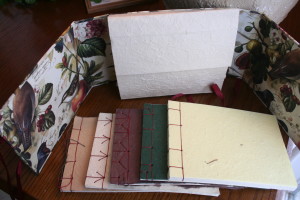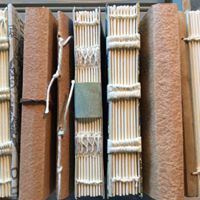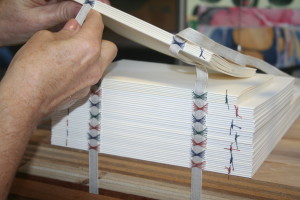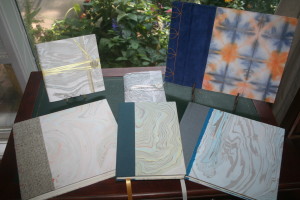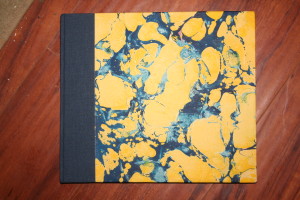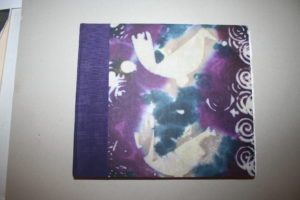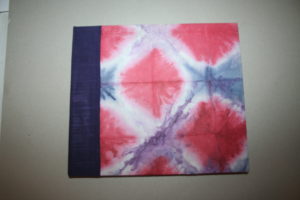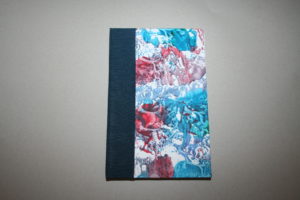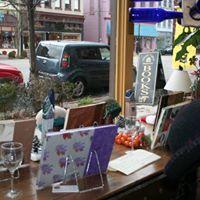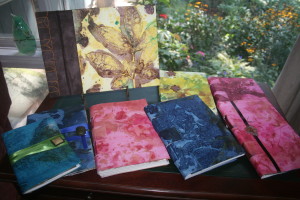Birdsong Books: From the Inside, Out
There are many kinds of book bindings, both exposed and covered.
Above is a box of traditional Japanese bindings. Books made with these bindings use a stab stitch to bind the pages and cover together. Examples of these elegant stitches include the “Noble Stitch,” or “Kanji Toni,” shown on the small red marbled journal and the “Tortoise-Shell Binding,” or “Kikko Toji,” on the large journal covered with blue and orange kozo paper that has been folded in various patterns and dyed.
The Cross-Structure Binding is a soft cover binding in which the signatures are sewn together with the cover, holding the book together.
Stitching for the Coptic Binding is done with a curved needle or multiple needles. The book has a flexible spine that is unsupported by paper or boards. It just is connected by the threads, which are connected with a chain stitch.
Case bound books are sewn on a frame, as shown below at right. Signatures are sewn and stitched together and strengthened with linen tape at intervals down the spine. The book block then is case-bound into the cover. Many kinds of stitches can be used for case bound books or those with open spines, as shown below. The photo (below right) shows signatures being sewn and stitched together.
Book Covers
All of the books and their covers have been handmade by the artist. The decorative paper covers use six different Eastern and Western techniques, which include:
- Suminigashi, a Japanese word for “ink floating,” is the oldest form of marbling. It originated in China more that 2,000 years ago before finding its own way to Japan. One floats pastel colored inks in water and blows on the inks to form the patterns. See below photo at left.
- Marbling has been practiced since the 15th century, probably originating in Turkey. Artists began floating colors on a thickened liquid similar to marbling size used today. Oils, watercolors and acrylics may be used. Below at the right is a case-bound book covered with marbled paper by the artist.
- Batik is another ancient art dating in some form to the Phoenicians, to China, Egypt, India, Greece, Peru, the Roman Empire and the early Christians. Wax designs are applied to the paper, followed by the dyes. Below at the left is a case-bound book covered with a batik paper by the artist.
- Kozo papers are folded and dipped into various dyes. When unfolded, repetitive patterns are created on the page, as shown in this case-bound book with paper decorated by the artist.
- Paste Papers recall the childhood delight of finger painting, a close relative. A paintbrush is used to coat paper with colored paste. Found items and other objects can be used to displace the paste and create patterns. Below on the right is a case-bound book covered with paste paper by the artist.
- Stamping: In the store window at the left is a large gray book decorated with stamped purple leaves.
Mixed Media Covers
Some of the processes used to decorate papers also make paintings to frame and hang on the wall. Most of these mixed media are “Dye and Salt Nature Printing,” which draws on the work of artist L. K. Ludwig. Leaves, feathers, fruits, weeds, grasses, and flowers can be cut and pressed into cold dyes painted onto paper and highlighted with salt. Several dye colors can be applied to the prints to add interest. Below is a sample of books covered with the artists’ dye-nature-salt patterned papers. They show different styles of bindings.
